
57th New York Film Festival
Burying our living
Halfway through the third story of Mariano Llinás’ wonderful composite-film La Flor (2019), Dreyfuss (Horacio Marassi), a kidnapped German scientist who finds himself tied in the backseat of a car in an unknown land, connects the dots of what he had gone through up until that point and tries to imagine his fate. As the French-speaking kidnappers drive him around deserted plains, he starts suspecting that they are only waiting for it to get dark:
– “The time has come. They will kill me.”
But they don’t. When the night falls, what hits Dreyfuss is not so much a bullet, but a moment of clarity. The European character played by an Argentinean theater actor with a European last name looks at the stars and realizes that, even though he cannot tell exactly where he is, he can say for sure where he is not.
– “I’m not in Romania. I’m in the South. Somewhere in the Southern hemisphere. (…) This is a new sky,” he thought. “I had never seen this sky before.” (…) The stars were the same ones, the constellations were the same ones, but they were inverted.
In that profound recognition of otherness that didactically demonstrates what ‘otherness’ means, Llinás’ camera tilts up from Dreyfuss, in the back seat of the car, and pans right towards the sky, framing the stars. For some, the constellations would appear to be upside down; for others, they are exactly the same way they have always been.

The inverted constellations in La Flor (2018), Mariano Llinás
If one could travel across films like an editor moves between shots, a dissolve from this remarkable moment under the Argentinean sky could seamlessly lead us to the opening shot of Juliano Dornelles’ and Kleber Mendonça Filho’s Bacurau. The theater screen is covered in black, with bright dots that glow long after their death, and Gal Costa’s voice comes from the past – more precisely, 1969 – singing a Caetano Veloso song called “Não Identificado” (“unidentified” or “not identified” – the lack of identification or the identification of the “not”), with words that cut through layers of tape delays and synthesizers:
I am going to write a song for her
A plain little Brazilian song to be released after Carnival
I will come up with a romantic iê-iê-iê
A sentimental anticomputer
I will write a love song
To record a flying saucer
The “Iê-iê-iê” was a very popular music genre description in Brazil in the 1960s and 1970s, following similar phenomena in Italy, Spain. France, and Portugal – where it was called Yé-yé. Named after the chorus in The Beatles’ worldwide hit “She Loves You,” the label embraces the misheard (“iê” has a closed, nasal sound, unlike the open “yeah, yeah, yeah”), suggesting perhaps an anti-colonial deformation, or even a parody, of the much-more-bellicose name that the scene received in English: The British Invasion. However, the opening song has been kept unsubtitled in the international version of Bacurau, adding another layer of foreignness – a kind of inside joke – to a film that feeds off that type of opacity.
While the spoken language is socially and temporally specific, tape delays and synthesizers are universal (in the way of Sun Ra), so buckle up. The camera pans left from the stars to show Earth hovering below, with a satellite humorously floating around it. Without a cut, a zoom-in focuses on a place on the map, like an overblown version of a Hitchcock location introduction: the fictitious town of Bacurau, “West of Pernambuco, Brazil” – a description that is both precise and diffuse, like the film is both specific and allegorical. It’s like Google Earth, except that, here, the constellations are upside down… it’s like the opening of a Hollywood film, except that here…
The film lands on the outskirts of the town, with an aerial shot that follows a water truck speeding down a deserted road. It’s a standard opening that recalls so many other films, to the point that they all begin to feel “unidentifiable” – like Caetano and Gal’s anticomputer iê-iê-iê. Genres have the ability to do that: they make the immediately recognizable unidentifiable. But only in the Southern Hemisphere they arrive on flying saucers. Despite the stars being the same, the generic speeding truck has a slightly harder time driving past the holes and bumps on that underdeveloped road compared to, say, Dennis Weaver in Steven Spielberg’s Duel (1971). The elements of the genre are all here – transported by radio waves, warships, and satellites – but, when the constellations are upside down, different shapes appear, for something gets lost and added in translation. “American music,” says Domingas (Sonia Braga) while listening to “True,” by the British new wave group Spandau Ballet. Iê, iê, iê.
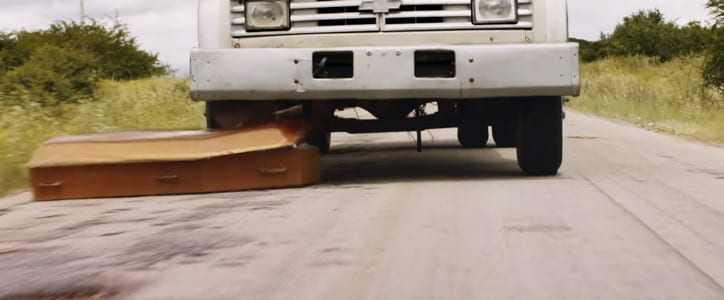
Traveling on this road is harder because it is also littered with obstacles – more precisely, coffins. As the speeding truck smashes them, one by one, the mental editing that took us from La Flor to Bacurau travels to the muddy European deserts passing as the Mexican border in Sergio Corbucci’s Django (1966), one of the greatest classics of Spaghetti Western (iê, iê, iê). The title character was named after Django Reinhardt, an extraordinary Belgian-Romani-French guitarist whose mythical skill was second-to-none, even though he had to make do without two of the fingers on his left hand, disabled by a severe burn. Played by Franco Nero, an Italian actor “discovered” by John Huston who has worked with some of the greatest directors in the world (Fassbinder, Chabrol, Buñuel, Bellocchio, Tarantino, etc), Django is a gunslinger who goes from town to town dragging a coffin behind him. “Is there somebody in there?,” they ask, but Django never answers. When he temporarily settles in a town controlled by a cormanesque ex-confederate major who shoots Mexicans as a sport (played by the Spanish actor Eduardo Fajardo – iê, iê, iê), Django finally opens the coffin. Instead of a body, he pulls out a machine gun and blows the shit out of everybody.
It’s an extraordinary prop, the coffin, for it collapses past, present, and future. Instead of a vehicle for mourning a death that has already happened, the film resignifies it as the promise of the deaths yet to come. Italian Westerns were not shot in the Southern Hemisphere but, detached from the domestic civilizational nobility of the genre, they reproduce its conventions using concave mirrors – a perverse form of mannerism. In the upside-down reflection, the constellations end up inverted, with Orion “holding its club upwards” (La Flor). The coffins are empty in Bacurau – bought in advance for deaths that have been planned, but not yet executed. But the film takes a clue from Django: the place of grief is also the place of action, of confronting the future with the experience of surviving a traumatic past. The bloodshed seems inevitable, but we don’t know whose blood will soak this land just yet.
The film creates an elaborate web that isolates the town, and the residents are enlisted to play a game they can’t escape, and that has a different rulebook made just for them. Meanwhile, Sudestinos (an underheard expression that names the people from the Brazilian Southeast – those who are very used to profiling the citizens of the Brazilian Northeast, like those who live in Bacurau, Nordestinos) cooperate with local politicians to accommodate the strange pastime of a group of foreign tourists who have come to town for a hunting competition that will make the town and its people vanish from the face of the Earth. Like the rabbit in Jean Renoir’s The Rules of the Game (1939), sacrificed for the pleasure of the bourgeoisie (the hunt as well as the movie itself), these characters have no way out; except, maybe, up or down.
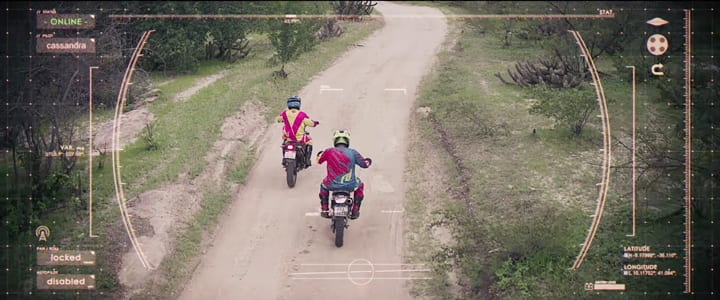
The stars over Bacurau say more than one can immediately read. When the echoey, fluttering synthesizers that open “Não Identificado” take the soundtrack, running with the opening credits, it is inevitable to remember that the two other fiction feature films directed by Kleber Mendonça Filho started from a similar pattern.
In Neighboring Sounds (O Som ao Redor, 2013) archival black and white photographs documenting the structures of the oligarchy in Recife – a centuries-old authority maintained through exploitation and physical terror – is animated by the building, layered percussion in Michel Colombier’s and Serge Gainsbourg’s “Cadavers en serie” (1968). The beat segues into a long take of two kids – a girl in rollerblades and a boy in a bike – roaming around the confines of their building’s parking garage until they reach the playground where other children and their nannies occupy stratified parts of the daily mise-en-scène.
In Aquarius (2016), Taiguara’s “Hoje” (1977) plays over archival black and white photographs of an idealized beachside past that slowly becomes more vertical, leading to a zoom-in into 1980, where cars roam on the beach sand and blast the latest Queen. The linear metric of “Another One Bites the Dust” contrasts with the spiraling movements of the car in the previous shot, echoing a classic moment in Ruy Guerra’s Cinema Novo landmark The Unscrupulous Ones (Os Cafajestes, 1962), self-reflexively turning a page in Brazilian culture.

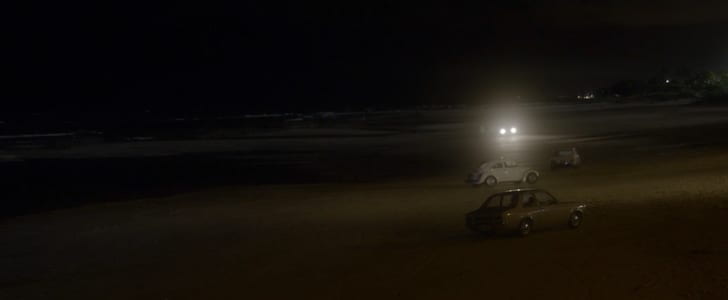
Aquarius (2016), Kleber Mendonça Filho
In all three films, the combination of music and indexes of temporal exchanges (different facets of an archival past in Neighboring Sounds and Aquarius; the surveillance of a CGI near-future in Bacurau) leads to displaced moving vehicles (the rollerblades and bike in the garage; the cars in the sand; the satellite and the water truck running over coffins) making the movies start in media res, capturing processes that are already in motion.
But a linear reading of the openings also establishes a peculiar historical timeline connecting all three films: in Neighboring Sounds, the maintenance of the oligarchy in Recife, 2013; in Aquarius, the dispute between different types of urban elites in 2016; and in Bacurau, the predatory destiny (“in a near future,” a title card says) that is being designed for all those social characters in the margins of the previous two films, unbeknownst to them. This narrative thread that ties the three films is an indication that the readymade connection between Bacurau and life-under-Bolsonaro might be fortuitous, but certainly not accidental. Kleber Mendonça Filho is a director of causal relationships – a peculiarity that makes him seem strangely American in the context of Brazilian cinema. But his sense of causality is more fitting to identify how social structures connect and develop than to show how the personal journey of an individual does – making him very Brazilian when compared to the dominant narratives of American cinema. This movement from the personal to the social finds a lot of visual and aural expressions in this latest film – from the use of split diopters that squeeze together two focal planes to the recurring shots that go from an extreme close-up to a wide shot, with the radical use of a crane.
But, while all three films have specific textures and colors – differences that are more pronounced in the shared direction of the latest feature, starting with the aforementioned CGI overture that both fits the pre-established auteurial pattern and bursts its seams from within – they all end up under the spell of the same genre: Brazilian history is best represented as a siege.
In the case of Bacurau, the siege is not really a British, but a Western invasion: iê, iê, iê. However, when looking at the siege format, the film privileges this peculiar intersection where exchanges take place even when they are extremely asymmetrical. One side might take more than they leave, but they can never control what will be made of what was left. “A Brazilian Western,” “John Carpenter in the Tropics,” or “a colonial nightmare” are all valid hypothetical attempts when trying to deal with the violence, both explicit and implicit, that barely holds the movie together. While this plot line alone could lead to a fairly stereotypical mode of anti-colonial critique, the film faces this invasion reflectively, inspired by the way Domingas tests the water of the impending future, offering Michael (Udo Kier) a homemade meal. Bacurau is, itself, invaded by a Western, twisted from the inside by an ambiguous fascination with a genre that is so foreign to that landscape, and at the same time so fitting to tell the story of permanent internal colonization that targets the Brazilian Northeast. What changes is basically the vantage point: the stars are all there, but the constellations are inverted. The genre is there but, in Brazil, even the title of Steven Spielberg’s Duel has been translated as Trapped (Encurralado).
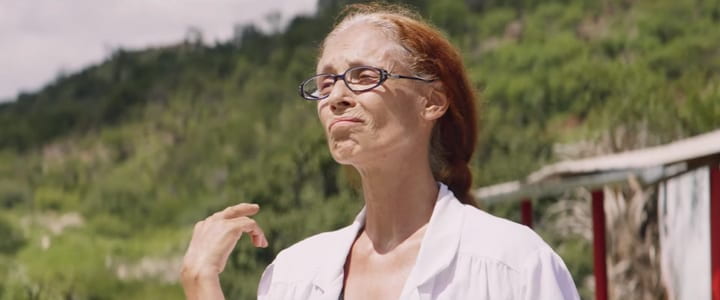
Finding constellations in the sky does not come naturally. In order to see the shapes that culturally identify them, one needs the power of imagination to connect the dots – like Dreyfuss in his argentinean adventure, or a film director who must have a certain kind of sensibility or training to decode the inner workings of a genre. It takes looking at a flying saucer and not only seeing it as a flying saucer, but also identifying it as a drone – a surveillance apparatus that doesn’t always blend with the landscape. That’s the beauty and the danger of it: a love song to record a flying saucer, with tape delays, synthesizers, and sounds from a future past… a Western in that part of the West which is more often referred to as the Global South. Brazilian Anthropophagy: cultural cannibalism as a mode of survival.
Coming out of the video store generation, Juliano Dornelles and Kleber Mendonça Filho master the formal requirements of the multiple genres that make the film – the arrival as inciting incident; the ticking clock as a tool of suspense; the elongated set-ups and the body-splitting payoff; the narrative choir played by the town’s busker (the repentista – a sarcastic storyteller typical of the Brazilian Northeast who is as close to Charles Bronson’s ominous Harmonica, in Sergio Leone’s Once Upon a Time in the West, as he is to the Greek aoido, or to Jards Macalé’s blind singer in Nelson Pereira dos Santos’ Amuleto de Ogum – iê, iê, iê). These patterns work in familiar, unidentified territory, demanding a gut reaction through the carefully rough orchestration of images and sounds. Yet, somewhat paradoxically, they all lead to what is most specific, to the coffin that belongs only to Bacurau: the museum.
A museum is a place that fossilizes and embalms the past in order to make it available for the present and the future. Bacurau is far from an idyll – there is prostitution, hangovers, some degree of poverty, and a programmatic draught that keeps the population hanging by a thread – but, like the man who asks to take a nap in the hospital bed, we have to work with what we have. What we have, in this case, is a list of names – some that sound familiar, others that don’t, but that perhaps should, hidden in opacity like the lyrics of the songs – names that people chant together when they are counting their dead.
This memorable sequence in the film might trigger some more immediate associations which are no less important – Marisa Letícia (the deceased wife of president Lula da Silva); and Marielle (the first name of Marielle Franco, a politician and activist executed over a year ago by the militia in Rio de Janeiro, whose assassination is yet to be completely solved). But perhaps a richer dramatic clue can be found in the name that was saved for last: João Pedro Teixeira.
Teixeira was a real-life peasant leader who was executed by mercenaries on a stretch of road between Sapé and Café do Vento (Paraíba – a state that border’s Kleber and Juliano’s Pernambuco) in 1962. In 1964, the filmmaker Eduardo Coutinho was shooting a fictionalized version of his life whose cast included his wife, Elizabeth Teixeira, playing herself. The shoot was interrupted halfway by the military coup. Troops raided the film set looking for what the official press had advertised as subversive material. The fictional account would remain incomplete, but Coutinho turned that interrupted attempt into a monumental feature-length documentary called Twenty Years Later (Cabra Marcado para Morrer, 1984) – an amalgam of personal experience, historical narrative, and self-reflexive meditation that marks the end of the Cinema Novo project, as well as the beginning of a different phase in Brazilian cinema.
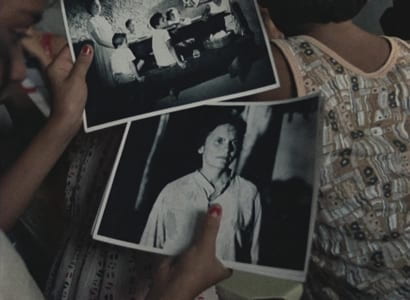
Elizabeth Teixeira in Twenty Years Later (1984), Eduardo Coutinho
The mention of João Pedro Teixeira’s name in the list of victimized heroes is more than a filmic reference: it points at an “alternative” history of Brazil whose most significant episodes have taken place in the Northeast. This history is not founded on Sergio Buarque de Holanda’s myth of cordiality, but on successive episodes of oppression and struggle that this very myth works to erase (in the past couple of years, it’s become quite obvious that the cost of not turning into museums the apparatus of death used by the military dictatorship between 1964 and 1984 has been too high, opening the possibility of programmatic distortion by apologists and deniers). It’s a lesson shared with Glauber Rocha and Frantz Fanon: the Bacurau museum preserves this iconography of struggle – Canudos, Malês, Palmares, the Cariris Confederation – for future reference. This is also our past, and it won’t be erased or forgotten by those who keep being forced to bury their living. So they remember it, keeping the blood prints, and hanging the guns on the wall, so that the passing of time and the violence of the sun can slowly trace their outline.
The siege is our daily bread, whether we’re inside the tightening circle, or are part of the circle itself. In a conversation with the filmmaker Ramon Porto Mota – who is from Paraíba, and not from the Southeast, like I am – he pointed out an aspect concerning the film’s title: bacurau is an angry nightbird that exists all over Brazil (in fact, between the south of Mexico and Argentina), but that is only called bacurau in the Northeast. This tension between the local and the external, the colloquial and the scientific, between meaning and matter, shoots back to the opening stars, the untranslated song, and the oblivious satellite: the fact that this place (of violence) and all it stands for (as possibility) has not been recognized does not mean it is not there.
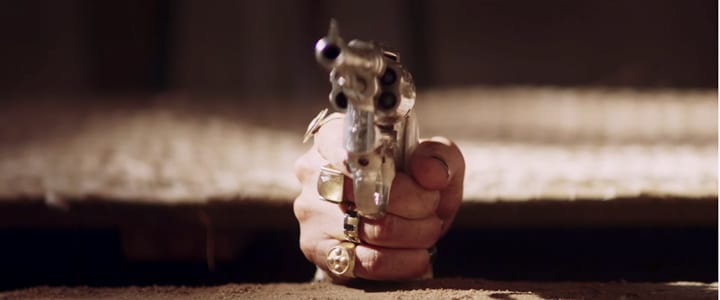 If you were to search for Bacurau on your map now, would it be there?
If you were to search for Bacurau on your map now, would it be there?
One needs to make their own maps, but they don’t need to make them alone. When the people of the town must get a hold of Lunga (Silvero Pereira), their protector in hiding, they use a mirror to reflect the sun, making a language out of light – the Northeastern light, as imprinted in Linduarte Noronha’s Aruanda (1960), Nelson Pereira dos Santos’ Barren Lives (Vidas Secas, 1963), Glauber Rocha’s Black God White Devil (Deus e o Diabo na Terra do Sol, 1964), Coutinho’s Twenty Years Later, and Marcelo Gomes’ Cinema, Aspirins, and Vultures (Cinema, Aspirinas e Urubus, 2005), among so many others. As all the technological devices fail to track the history written not only on the ground but also underneath it, what the film’s third act reserves is not merely a cathartic bloodshed. That was long in the making. Instead, Bacurau makes a much more suggestive statement: those who are constantly invisibilized get better at being invisible. We learn how to hear the “yeah, yeah, yeah,” but we also learn how to turn it into a iê, iê, iê, a sentimental anticomputer to be released as a love song to the near-future, after the feast and the carnage of Carnival.






Wow!
fabio que impressionate sua leitura do filme. The reading is deep and transversal crossing Both te coutrys history and cinema’s. Wow indeed.
muito obrigado, ivone, seu comentário fez meu mês aqui!